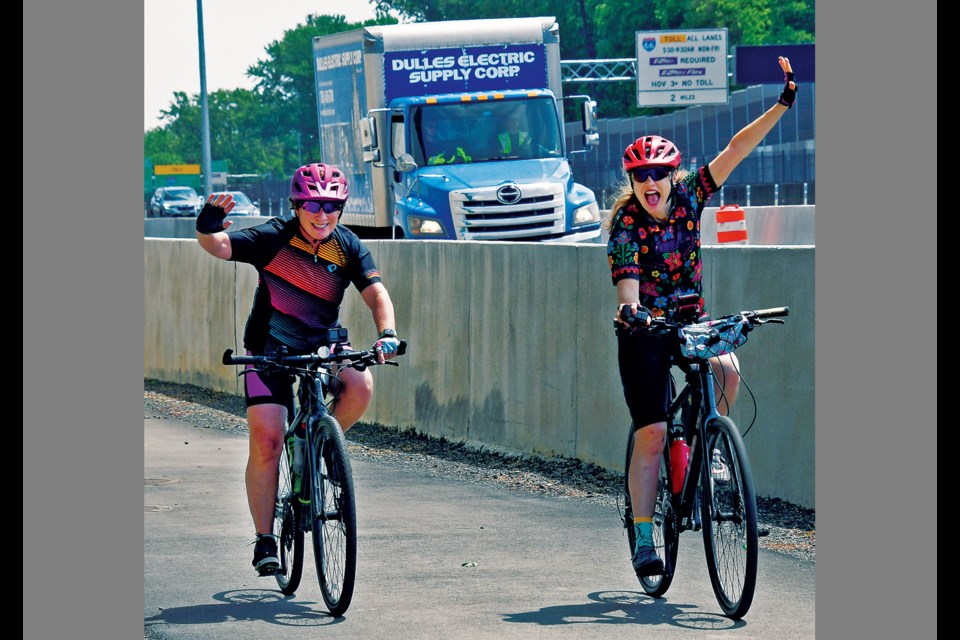[Updated 5/23/23 with additional photos]
It’s loud, with cars and trucks zooming just on the other side of concrete barriers, but part of the new I-66 Parallel Trail now is open to cyclists and pedestrians.
Virginia Department of Transportation (VDOT) officials, along with county leaders, state delegates, and representatives from I-66 Express Mobility Partners and design-build contractor FAM Construction, on May 17 dedicated the first two sections of the 18-mile-long shared-use trail, which is being built as part of the Transform 66 Outside the Beltway Project.
The $3.7 billion Express Lanes project’s mission is to make the I-66 corridor more accessible, reliable travel option for everyone, said Steve Hankins, chief infrastructure officer for I-66 Express Mobility Partners.
“To us, true mobility and accessibility means making it easier to move goods, people and services along 66, not just cars.”
Officials cut the ceremonial tape in the north parking lot of the Vienna-Fairfax/GMU Metrorail station. Visitors picked up bottles of water, packets of trail mix and tiny clip-on LED lights for their bikes.
The event drew plenty of helmeted, Spandex-clad bicyclists, who rejoiced in the trail’s opening and mounted their bikes to check it out.
“As an avid cyclist, it is like torture to come here today and not be dressed ready to cycle,” said Board of Supervisors Chairman Jeff McKay (D).
Cyclists and pedestrians rode or walked west on Virginia Center Boulevard and went through a short tunnel under Nutley Street before heading on a brief excursion to Cedar Lane and back along I-66.
The 10-foot-wide asphalt path eventually will run between Dunn Loring and Centreville, but the only sections open now are between the Vienna Metrorail station and Cedar Lane in the Vienna area and between Blake Lane and Route 123 in Oakton. Gaps between some sound walls allow for connections with residential neighborhoods along the trail.
Other segments of the trail are under construction and transportation officials hope to open them gradually throughout the summer, said Heidi Mitter, VDOT’s pedestrian, bicycle and park-and-ride-lot coordinator.
Project designers had to overcome some obstacles, she said.
“Right-of-way is always a challenge, [along with] physical space constraints,” Mitter said. “There are some areas where [the trail’s width] had to be narrowed down.”
Only one short section of the trail, located north of the Vienna Metrorail station, will segregate bicycle and pedestrian uses. That project, being built by VDOT in coordination with Fairfax County, will echo efforts being implemented by the Northern Virginia Regional Park Authority (NOVA Parks) along the Washington & Old Dominion Regional Trail, she said.
Cyclist Paul Hopgood of Fairfax said he plans to use the I-66 Parallel Trail for exercise and hopes that the project will open up more bicycle routes.
“I think it’s fantastic,” said Bruce Wright, president of the Fairfax Alliance for Better Bicycling (FABB), who will both commute and exercise along the path.
“Many of the crossings, ramps and roads are grade-separated,” he said. “That’s huge. That allows cyclists to go a longer distance and without having to stop at an intersection. It’s much safer for everybody.”
The Transform 66 Outside the Beltway Project also will feature pedestrian and bicycle amenities on the new bridges, added Wright, who lives in Reston.
FABB advocated for a path along I-66 at the project’s start by having cyclists write to VDOT and encourage them to follow Fairfax County’s comprehensive plan, which called for such a trail.
The I-66 trail is not perfect, Wright said. Cycling advocates would have preferred more segments to be located on the other side of the highway’s sound barriers. Residents living adjacent to the Lee-Custis Trail in Arlington have found the amenity to be a selling point for their properties, he said.
“VDOT was excellent in working with us and others in the cycling community to do the best they could,” Wright said.
During initial meetings for the I-66 project in 2014 and 2015, now retired Fairfax County Department of Transportation Director Tom Biesiadny said there needed to be a trail along I-66, said Susan Shaw, VDOT’s Northern Virginia Megaprojects director.
“I said, ‘What are you talking about? It’s an interstate. Get real!’” she recalled. “But we learned along the way, and sure enough, we managed to get one in.”
Project officials also benefited when FABB members took them on a field trip to the Lee-Custis Trail in Arlington to demonstrate which features they sought and which they wished to avoid.
“It really opened our eyes to some of the issues that people see,” Shaw said.
“We didn’t let this once-in-a-lifetime opportunity pass us by,” said Sonya Breehey, a past president of FABB who still serves on the group’s board. “We quickly mobilized and started up a campaign to make it happen.”
Hundreds of supporters from FABB and other area cycling groups showed up and testified at many public meetings to show how much support there was for the trail, she said.
McKay said he did not consider locating a shared-use path next to a highway to be an unusual proposition.
“It’s not weird, it’s actually fundamental,” he said. “Whenever we build infrastructure in Fairfax County, we need to be thinking about multi-modal connections, how people can bike, how people can get to and from work or wherever they’re going without necessarily having to get into their cars.”
“It really, truly is the future of where we are headed,” said Supervisor Dalia Palchik (D-Providence). “I think that the future is very bright for bicyclists and for strollers.”



